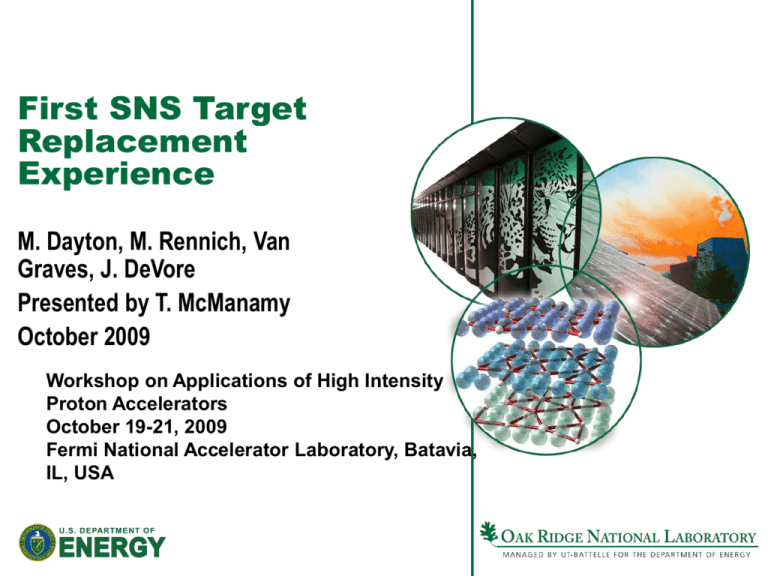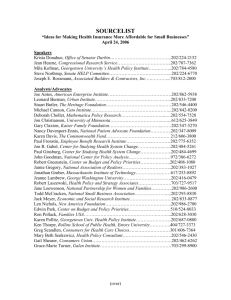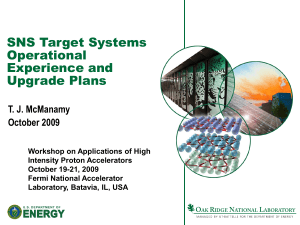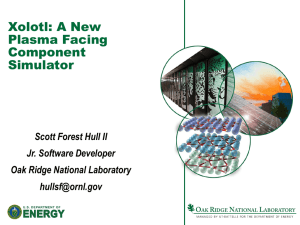Slide
advertisement

First SNS Target Replacement Experience M. Dayton, M. Rennich, Van Graves, J. DeVore Presented by T. McManamy October 2009 Workshop on Applications of High Intensity Proton Accelerators October 19-21, 2009 Fermi National Accelerator Laboratory, Batavia, IL, USA Overview • Initial Target Replacement • Target Maintenance Environment – – – – Target Service Bay Maintenance Equipment Target Process Configuration Radiation and Contamination • Target Change-out Operations • First Change-out Experience 2 Managed by UT-Battelle for the U.S. Department of Energy AHIP Workshop Oct. 2009 First SNS Target Replacement • Replacement of the first SNS target was successfully completed during a planned outage in August 2009 – Over 3000 Megawatt-hours of accumulated energy had resulted in dpa damage levels which necessitated replacement of the first Target Module – As beam power levels increase, Target Module replacements could occur ~ 4 times per year 3 Managed by UT-Battelle for the U.S. Department of Energy AHIP Workshop Oct. 2009 First SNS Target Replacement • Replacement of the target module was accomplished using only remote handling tooling and procedures (hands-on operations are not possible) • While the tooling and procedures utilized enabled successful replacement of the target, several design and operational concerns were highlighted during the process • The following charts give an overview of the target replacement process along with the insights gained 4 Managed by UT-Battelle for the U.S. Department of Energy AHIP Workshop Oct. 2009 Target Change-out Environment • A shielded “Target Service Bay” located downstream of the target-proton beam interaction monolith serves several key functions: – Enclosure of the mercury process – Maintenance of the mercury process equipment, including the target – Processing and disposing of spent mercury processing equipment – Constructed using 1 meter of high density concrete • The Target Service Bay is designed for full remote operation. An array of sophisticated remotely operable tooling is deployed inside the cell with a bridge mounted servo-manipulator as the key element. 5 Managed by UT-Battelle for the U.S. Department of Energy AHIP Workshop Oct. 2009 Target Service Bay 6 Managed by UT-Battelle for the U.S. Department of Energy AHIP Workshop Oct. 2009 Target Service Bay Servo-Manipulator Target Cart Service Bay Size: 31.4 meters x 4.3 meters 7 Managed by UT-Battelle for the U.S. Department of Energy AHIP Workshop Oct. 2009 Mercury Pump Telerob EMSM 2B Servo-Manipulator • The servo-manipulator is the defining feature of the SNS hot cell: Master-Slave Manipulator – Dual-arm, high performance servomanipulator provides full cell coverage. – Mounted on a 4-degress of freedom bridge and boom system. – Master arm position control with Force Feedback – Digital Control – 50 lb Continuous Capacity/100 lb peak. – Three On-Board CCTV Cameras – 500 lb capacity Aux Hoist Servo-Manipulator 8 Managed by UT-Battelle for the U.S. Department of Energy AHIP Workshop Oct. 2009 Maintenance Equipment • Four window workstations each containing a pair of master-slave manipulators are built-into the target service bay. Only one is workstation is dedicated to target change-out. • The servo-manipulator is required to perform most operations including bolt torquing, tool transport, inspections and precision operations. Manipulator Gallery 9 Managed by UT-Battelle for the U.S. Department of Energy AHIP Workshop Oct. 2009 Remote Handling Control Room Mercury Process Configuration • The mercury process is simple and highly reliable. It circulates ~1.4 cubic meters (20 tons) of mercury with a centrifugal sump pump through the target and tube-inshell heat exchanger at the rate of 16 l/s. • A 2” dump valve (all metal) used to drain the mercury to a shielded storage tank is the only active element. • However, the process loop requires numerous complicating elements such as; monitoring sensors, off-gas control vents, spill recovery lines, and power, vacuum and compressed air services. 10 Managed by UT-Battelle for the U.S. Department of Energy AHIP Workshop Oct. 2009 Mercury Process Configuration Radiation Detector located on return line 11 Managed by UT-Battelle for the U.S. Department of Energy AHIP Workshop Oct. 2009 Radiation Environment • During Beam-On Operations – Mercury process equipment contact radiation level is ~400 gray/hr – Steel shielding (.2 - .3 m) inside cell reduces area background to ~ 2 gray/hr • During Maintenance Operations – With mercury drained from process lines, residual contamination results in contact radiation levels of 3-5 gray/hr • Target Radiation Levels (following 400 kW operation) – ~14 gray/hr at 1.1 m six days after shutdown – Full power targets (2 MW operation) are expected to be ~ 70 gray/hr at 1.1 m 12 Managed by UT-Battelle for the U.S. Department of Energy AHIP Workshop Oct. 2009 Radiation Environment • Dose rates measured on Mercury Process Piping SNS Radiation Measurements After Shutdown ~ 5 Gray 1 Week (Target Cart Retraction) Chengeng Zeng/David Freeman, ORNL 13 Managed by UT-Battelle for the U.S. Department of Energy AHIP Workshop Oct. 2009 Contamination Environment • Experience has shown that the isotopic particulate contamination is long-lived and wide-spread inside the Service Bay. At the end of the first target change-out the cell background away from the process area had risen from essentially clean (10,000 disintegrations/min smears) to 400 mrad/h smears. – Service Bay contamination has also migrated to the Transfer Bay due to in-cell ventilation systems and movement of the in-cell crane and servo-manipulator into the Transfer Bay as a part of normal operations • A recent localized survey yielded 3,000,000 disintegrations/min smears in the Transfer Bay 14 Managed by UT-Battelle for the U.S. Department of Energy AHIP Workshop Oct. 2009 Mercury Vapor Environment • Opening the mercury process lines results in an expected increase in mercury vapor in the Service Bay during replacement operations • Once exposed to atmosphere, the mercury forms an oxide layer that mitigates vaporization until disturbed by vibration or movement • The following charts depict the spikes seen in mercury vapor levels in the Service Bay (in micro-g/m3) during operations involving the mercury process system 15 Managed by UT-Battelle for the U.S. Department of Energy AHIP Workshop Oct. 2009 Mercury Vapor Environment September, 2006 Outage Hg Concentration Initial Shield Block Removal Initial Hg Cart Pushback Empty Hg catch pots, reinsert cart to monolith Hg sample initial system breach Loop Evacuation and Filling Loop Drainage to storage tank Install gaskets Service Bay Entry Transfer Hg sample, cell cleanup Taking Hg Sample Analyzer Calibration 16 Managed by UT-Battelle for the U.S. Department of Energy AHIP Workshop Oct. 2009 Analyzer Calibration Mercury Vapor Environment Hg Vapor (micro-g/m3) First Target Replacement Hg Concentrations 17 Managed by UT-Battelle for the U.S. Department of Energy AHIP Workshop Oct. 2009 Mercury Vapor Environment • The mercury vapor environment also leads to widespread condensation of mercury on surfaces within the Service Bay unrelated to the Target replacement operations Mercury condensate on Target Cart surfaces 18 Managed by UT-Battelle for the U.S. Department of Energy AHIP Workshop Oct. 2009 General Reliability Considerations • The target and target process are single-point failure elements for the SNS facility. • With an expected life of a few months the target change-out operation was the focus of the cell design. The mission goal was a target exchange in five days with an expected target changeout rate of four per year. • Change-out (repair is not feasible) of the larger process equipment will be difficult and time consuming. Lifetimes for the heat exchanger, pump and dump valve is expected to be greater than 7 years. With preventative maintenance monitoring changeout of this equipment can be performed during planned facility shut-downs. • Redundancy was evaluated and found to reduce reliability by introducing more components and complexity to the process. • The servo-manipulator is required to perform virtually all process equipment operations. It has redundant bridge drives to move the system to the transfer bay for hands-on maintenance. 19 Managed by UT-Battelle for the U.S. Department of Energy AHIP Workshop Oct. 2009 Major Target Replacement Operations • Removal and Reinstallation of the following components take place during each target replacement: • Four pieces of in-cell shielding (14 tons of steel) • Nine process and utility jumpers at the back of the target cart (1/2 inch fittings in addition to instrumentation connectors) • Two 2” and two 6” water coolant and mercury process lines • Seven process and utility jumpers at the target (1/2” to 2”) • One spent and one new target module (8 ea. 1” tie-down bolts and 4 ea. jack screws) • Other operations include: • Movement of the 100 ton target cart over 9 meters • Handling of over 50 pieces of tooling • Capture and return of released liquid mercury from open pipes • Requires four person crew/one shift operation 20 Managed by UT-Battelle for the U.S. Department of Energy AHIP Workshop Oct. 2009 Planning versus Experience • Extensive procedural development and cold mock up testing efforts resulted in a successful target module replacement process • Initial reluctance to introduce complexity (and the associated risk) to the process drove early decisions to forego complex redundancy and interim testing measures to the design and replacement process • The recent fully-remote replacement operation focused attention on several areas of risk with this approach – Interim process fitting leak testing – Limitations on remote handling equipment reliability – Limitations on remote handling equipment capability 21 Managed by UT-Battelle for the U.S. Department of Energy AHIP Workshop Oct. 2009 Issue 1: System Connection Test Difficulties • Due to the lack of valving in the target process loop, change-out connections cannot be tested until the Target Cart is fully inserted. Additionally, access to many of the system connections are precluded due to full insertion of the Cart. • Four target systems are potentially impacted: • • • • Mercury loop Coolant water loop Target Seal Helium pressure Target Seal Vacuum Coolant Loop Jumper Removal using the servo-manipulator and master-slave manipulators simultaneously 22 Managed by UT-Battelle for the U.S. Department of Energy AHIP Workshop Oct. 2009 Issue 1: System Connection Test Difficulties • Mercury loop integrity testing is accomplished using a vacuum leak test when the system is fully assembled (target cart fully inserted) – Initial vacuum testing indicated a substantial leak • Leak detection activities were impacted as only three of the five mercury process loop connections are accessible with the Target inserted. Retraction of the Target to access the remaining two connections precluded testing due to the open process loop. • Test fixtures and procedures were developed real-time to enable the leak to be identified. It was ultimately fixed by simply tightening a loose fitting. 23 Managed by UT-Battelle for the U.S. Department of Energy AHIP Workshop Oct. 2009 Issue 1: System Connection Test Difficulties • It took approximately 3 weeks to work though this problem. Many of the tools and procedures developed during that period will be used regularly in future replacements to avoid a repeat. • Additional procedures will be developed to enable interim testing of the remaining three systems (water, helium and vacuum) to identify potential problems prior to insertion of the Target Cart. – These procedures add complexity, time and risk to the replacement process 24 Managed by UT-Battelle for the U.S. Department of Energy AHIP Workshop Oct. 2009 Issue 1: System Connections Target utility jumpers are tightly packed. This makes remote access to the fittings difficult. Jumpers between Target and Target Cart Re-connection of utilities between Target Cart and Facility 25 Managed by UT-Battelle for the U.S. Department of Energy AHIP Workshop Oct. 2009 Issue 2: Counter-intuitive Target Cart Locking Mechanism • The target cart is spring-loaded in the operating position to accommodate thermal expansion with an unnecessarily complex locking mechanism. – During Target Cart insertion, brake pins are inserted at the aft portion of the Cart and then heavily-preloaded springs act against the pins to maintain a preload on the Cart • Subsequent retraction of the pins requires removal of this preload – During remote operations it was very difficult for the operators to assess the point at which the preload had been removed prior to retracting the brake pins • The initial pin retraction attempt resulted in deformation of the portion of the structure that applies force to retract the brake pins 26 Managed by UT-Battelle for the U.S. Department of Energy AHIP Workshop Oct. 2009 Issue 2: Counter-intuitive Target Cart Locking Mechanism Brake pin preload/insertion mechanism Brake pins Locking Mechanism at Aft End Of Target Cart 27 Managed by UT-Battelle for the U.S. Department of Energy Using pneumatic wrench to preload springs AHIP Workshop Oct. 2009 Issue 2: Counter-intuitive Target Cart Locking Mechanism • The mechanism remains functional but the damage has resulted in further difficulties in ensuring proper pin engagement • This issue highlights the need to design remotelyoperated hardware in such a way to ensure robustness and mitigate technician judgment 28 Managed by UT-Battelle for the U.S. Department of Energy AHIP Workshop Oct. 2009 Issue 3: Torque Tools • Proper torquing is important for many target related connections; this proved to be more difficult than the cold mockup tests indicated. • Pipe and tubing jumpers are generally tightened with manual wrenches. It was found that ensuring the correct torque application for threaded connections was difficult due to the design of the manual torque wrenches. • The target tie-down bolts were torqued with sophisticated pneumatic motor driven tools with the capability of remote torque and speed adjustment. While functionally these have operated very well lubrication has proven to be more difficult than planned… Torquing of Target Bolts Torquing of Coolant Line Flange 29 Managed by UT-Battelle for the U.S. Department of Energy AHIP Workshop Oct. 2009 Issue 4: Thread galling • Stainless steel fittings and fasteners are used extensively through out the process. While galling has not been a problem to date the extreme consequences make it an ever present threat during remote operations. • One of the single-bolt Grayloc connectors galled during pre-ops testing. This lead to a policy of regularly using anti-seize on threads considered to be vulnerable. • A means of remotely applying anti-seize on threads is currently being developed. Anti-seize visible on threads Removal of Coolant Line Jumper 30 Managed by UT-Battelle for the U.S. Department of Energy AHIP Workshop Oct. 2009 Issue 5: Maintenance Tool Reliability • The remote handling equipment is the most complex and delicate equipment in the Service Bay – Common issue in cells where light weight and dexterous tools are inherently less rugged than process equipment • The SNS remote handling tooling performed well, however several delays were experienced – Several servo-manipulator grip (finger) repairs – Master-slave manipulator removal for hand repair – Failure of a pneumatically-operated wrench • Failures resulted in approximately 14 hours of lost time • Tool failures compound operational difficulties by extending time and usage of the remote handling equipment leading to increased tool failures 31 Managed by UT-Battelle for the U.S. Department of Energy AHIP Workshop Oct. 2009 Conclusion • The first SNS Target Module was successfully replaced during a planned 45-day facility maintenance shutdown. • Planned target change-out operations fit within the design goal period of five days. • Un-planned events caused significant delays and highlighted areas in which the tooling, process components and operations can be improved. • The un-planned events experienced are relevant to many mercury process system elements and therefore are of broad concern. 32 Managed by UT-Battelle for the U.S. Department of Energy AHIP Workshop Oct. 2009









